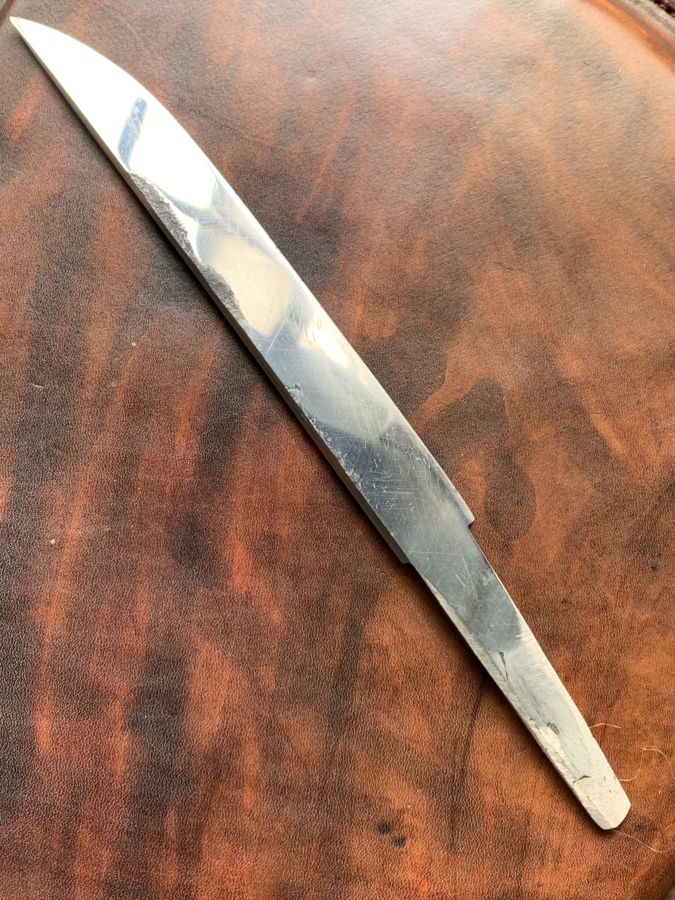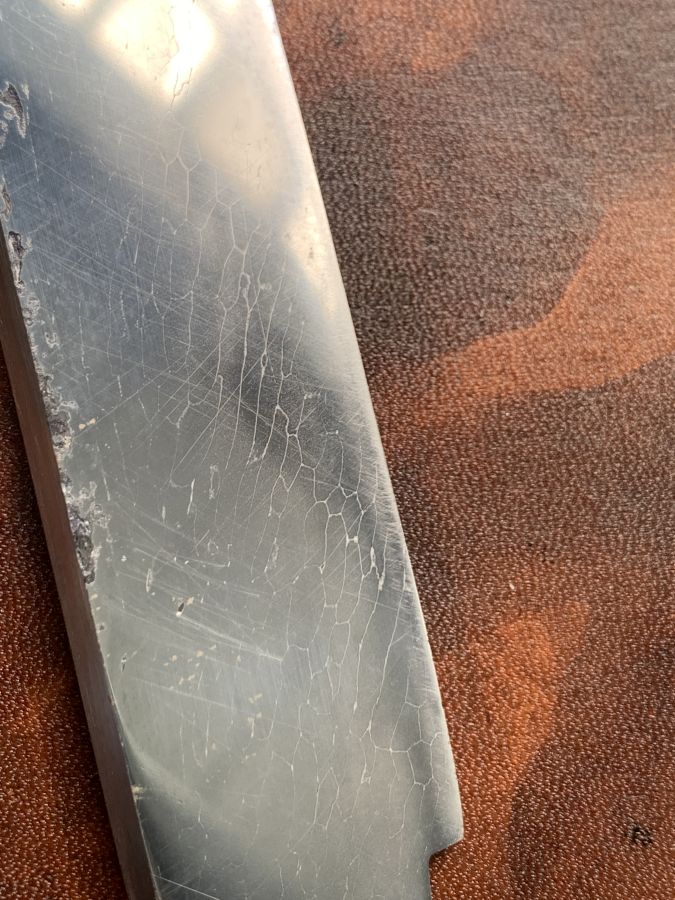This was an experiment welding test, that I got a bit carried away with.
I started with a short chunk of cable (wire rope, really) then fluxed it up and mashed it down. It appeared to weld pretty well. Yay! I’m still getting my little forge dialed in, and I interpreted this as “dialed.”
I thought I’d make some aggressive crushes with the hydraulic press, to make sure the welds were tight and pretty quickly I had made the thing into a 1/4″ by 1 1/2″ bar. It looked kind of knife-like! All it needed was the tip to be chopped for turning, and then some clean up and grinding. On the spot I decided to semi-finish it by leaving it rough, but sharpening it, anyway.

Rough grinding and shaping was next, then I clayed it up and quenched it. That process went great. It seemed as though the fates wanted this to be a blade. Then I made a momentous decision, which was to grind the flats perfectly flat. That’s how I did it. Then, I decided – “in for a penny, in for a millon” – to do a mirror finish on it. Why not? It’s just glass-hard martensite edge, and forge scale, now. Piece of cake. Flattening it and polishing it was 6 days on and off, working at my polishing bench. Quite relaxing, really: put on some music and enjoy the fall weather while zoning out into the movement.

close up
The lines are the leftover spaces between the wires, which are welded, but those spaces are more carbon-rich and a bit softer. It doesn’t take much difference to have an effect.
You can see the temper-line (“hamon”) in the blade. That’s the transition zone between the martensite-stage steel comprising the cutting edge and the pearlite back/spine of the blade.
How am I going to finish it? Or, will I finish it at all? I don’t know. The next stage in the process would be to make the blade collar (“habaki”) which is about 2 days of work. I’ll probably do that, and that unlocks the possibility of doing a guard, handle, etc. I had a weird idea the other day, which is to stick with the beastly crudity and cast a silver guard based on some rotting plywood that I have – it’s got a really cool texture. I’m going to make some silicone impressions of the plywood and cast some wax into them and see if I can assemble them and rough-shape them into something interesting. If that works and it’s cool, I may attempt to do a handle and scabbard out of resin-infused plywood. It’s all very vague. This could easily take years. Plan B is to make a lovely little stand for it, and find a home for it.

Knifey-spoony is meaningless to me, but I love to see you writing more. May it last.
I love watching this sorta stuff on YouTube. Had a misogynist for a father who thought that girls shouldn’t know how to use tools. When I moved out, I pestered the guys in the local hardware shop to show me how to use most basic tools and a few of the more exotic ones . So I kinda sorta knew what you were talking about . I’m also glad to see you’re ok . I usually don’t comment but I read it sometimes
The lines left by the cable wires are pretty cool. The new forge seems to be working very well!
Ooh, very cool
If you send it to me I’ll put a horribly inauthentic handle on it :P
My two cents: it’s a beautiful piece, and once finished I’d simply put it on a single-holding katanakake, no handle no nothing, just the blade resting on it.
One could call it “appreciating the lines of the naked blade”, or maybe “the lazy-ass solution”, but once I saw some blades presented that way in Japan (on the Osaka castle museum), and I was quite blown away.
@outis
My understanding is that Japanese culture traditionally appreciated the blade itself as art, while European cultures considered the blade a base to work on. The different construction also allows Japanese blades to be disassembled, while European blades are generally all fixed construction.
So you can display the naked blade, and that allows you to appreciate the skill of forging the entire blade.